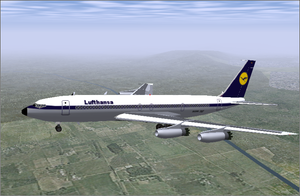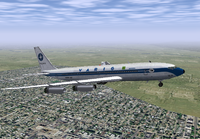Boeing 707-400: Difference between revisions
Jump to navigation
Jump to search
No edit summary |
No edit summary |
||
| Line 6: | Line 6: | ||
|fdm =JSBsim | |fdm =JSBsim | ||
|status =Development | |status =Development | ||
|authors =Innis Cunningham, Erik Hofman (FDM) | |authors = Isaias V. Prestes, Innis Cunningham, Erik Hofman (FDM) | ||
|fgname =707-400 | |fgname =707-400 | ||
|download =http://presteshangar.wikidot.com/boeing-707-400 | |download =http://presteshangar.wikidot.com/boeing-707-400 | ||
| Line 19: | Line 19: | ||
The Boeing 707 is a four-engine commercial passenger jet airliner developed by Boeing in the early 1950s. Its name is most commonly pronounced as "Seven Oh Seven". Boeing delivered a total of 1,010 Boeing 707s, and also offered a smaller, faster model of the aircraft that was marketed as the Boeing 720. | The Boeing 707 is a four-engine commercial passenger jet airliner developed by Boeing in the early 1950s. Its name is most commonly pronounced as "Seven Oh Seven". Boeing delivered a total of 1,010 Boeing 707s, and also offered a smaller, faster model of the aircraft that was marketed as the Boeing 720. | ||
== Development == | == Development == | ||
| Line 27: | Line 26: | ||
* The final major derivative was the '''707-320''' which featured an extended-span wing and JT4A engines. | * The final major derivative was the '''707-320''' which featured an extended-span wing and JT4A engines. | ||
* The '''707-420''' was the same as the -320 but with '''Rolls-Royce Conway turbofan engines'''. British certification requirements relating to engine-out go-arounds also forced [[Boeing]] to increase the height of the tail fin on all 707 variants, as well as add a ventral fin, which was retrofitted on earlier -120 and -220 aircraft. These modifications also aided in the mitigation of dutch roll by providing more yaw stability. | * The '''707-420''' was the same as the -320 but with '''Rolls-Royce Conway turbofan engines'''. British certification requirements relating to engine-out go-arounds also forced [[Boeing]] to increase the height of the tail fin on all 707 variants, as well as add a ventral fin, which was retrofitted on earlier -120 and -220 aircraft. These modifications also aided in the mitigation of dutch roll by providing more yaw stability. | ||
[[File:707-400b.png|200px|thumb|left|The VARIG 707-400 PAX]] | |||
== The -400 Series == | == The -400 Series == | ||
The '''707-420''' is a version of the 707-320 originally produced at specific request for BOAC and powered by '''Rolls-Royce Conway 508 turbofans''', producing 17,500 lbf (77.8 kN) each. Although BOAC initiated the programme, [[Lufthansa]] was the launch customer and Air India was the first to receive a 707-420 on February 18, 1960. A total of 37 were built to this configuration. | The '''707-420''' is a version of the 707-320 originally produced at specific request for BOAC and powered by '''Rolls-Royce Conway 508 turbofans''', producing 17,500 lbf (77.8 kN) each. Although BOAC initiated the programme, [[Lufthansa]] was the launch customer and Air India was the first to receive a 707-420 on February 18, 1960. A total of 37 were built to this configuration. | ||
[[File:707-400c.png|200px|thumb| | [[File:707-400c.png|200px|thumb|right|Rolls-Royce Conway turbofan engines]] | ||
== External Links == | |||
* [http://www.boeing.com/commercial/707family/ Boeing 707 family on Boeing.com] | |||
* [http://www.airlinercafe.com/page.php?id=72 Detailed guide to all variants of the 707/720 on airlinercafe.com] | |||
* [http://www.airliners.net/aircraft-data/stats.main?id=87 Boeing 707 page on Airliners.net] | |||
== Reference == | == Reference == | ||
Revision as of 22:29, 25 October 2009
 | |
| Type | Airliner |
|---|---|
| Author(s) | Isaias V. Prestes, Innis Cunningham, Erik Hofman (FDM) |
| FDM | JSBSim |
| --aircraft= | 707-400 |
| Status | Development |
| Download |
|
This includes the following models: 707-400
The Boeing 707
The Boeing 707 is a four-engine commercial passenger jet airliner developed by Boeing in the early 1950s. Its name is most commonly pronounced as "Seven Oh Seven". Boeing delivered a total of 1,010 Boeing 707s, and also offered a smaller, faster model of the aircraft that was marketed as the Boeing 720.
Development
- The initial standard model was the 707-120 with JT3C engines. Qantas ordered a shorter body version called the 707-138, which was a -120 that had six fuselage frames removed, three in front of the wings, three aft. The frames in the 707 were each 20 inches (500 mm) long, so this resulted in a net shortening of 10 ft (3 m) to 134 ft, 6 inches (41 m). Because the maximum takeoff weight remained the same 257,000 lbs (116 Tonne) as the -120, the 138 was able to fly the longer routes that Qantas needed.
- Braniff ordered the higher-thrust version with Pratt & Whitney JT4A engines, the 707-220.
- The final major derivative was the 707-320 which featured an extended-span wing and JT4A engines.
- The 707-420 was the same as the -320 but with Rolls-Royce Conway turbofan engines. British certification requirements relating to engine-out go-arounds also forced Boeing to increase the height of the tail fin on all 707 variants, as well as add a ventral fin, which was retrofitted on earlier -120 and -220 aircraft. These modifications also aided in the mitigation of dutch roll by providing more yaw stability.
The -400 Series
The 707-420 is a version of the 707-320 originally produced at specific request for BOAC and powered by Rolls-Royce Conway 508 turbofans, producing 17,500 lbf (77.8 kN) each. Although BOAC initiated the programme, Lufthansa was the launch customer and Air India was the first to receive a 707-420 on February 18, 1960. A total of 37 were built to this configuration.
File:707-400c.png
Rolls-Royce Conway turbofan engines
External Links
- Boeing 707 family on Boeing.com
- Detailed guide to all variants of the 707/720 on airlinercafe.com
- Boeing 707 page on Airliners.net
Reference
- [*http://en.wikipedia.org/wiki/Boeing_707 Wikipedia]
| |||||||||||
